Barat Ali Batoor’s photos of Afghanistan and its people have an intensity and empathy that only someone close to the subject could capture. The self-taught photographer and Walkley award winner talks to Anthony McKee about his life, his approach to photojournalism and the life-threatening journey that brought him to Australia.
When you first hear about the Dancing Boys of Afghanistan, you hope it might be one of the few happy stories to emerge from the war-torn country, but it’s not. In one of the most oppressive cultures in the world, where gender segregation often prevents young men from meeting their brides-to-be until their wedding day, some Afghan males look towards boys instead to be both their companions and sexual partners. These boys are groomed from their pre-teen years to wear dresses and make-up, and dance for the entertainment of male groups. Unlike the women in Afghanistan, who are typically confined to their homes, these boys can also be taken freely about the towns and countryside. However, these relationships aren’t based on commitment and love, but exploitation. When the boys begin to mature and grow beards they are discarded for younger boys.
The plight of these Bachi Baazi (a name which can refer to “Boys of Pleasure” or playing with boys) might not have been told were it not for the efforts of a local photojournalist, Barat Ali Batoor, who spent six months taking photographs of these Afghan boys and the men who groom them. While Australian photographers and journalists enjoy the right of free speech, in Afghanistan the idea of sharing the culture’s secrets is practically forbidden. Trying to get the story published locally proved impossible and it was only when The Washington Post newspaper published the photo essay in April 2012 that the world got a rare insight into this tragic aspect of life in Afghanistan.
Although it was published on the other side of the world, it didn’t take long for Afghan officials to hear about the photo essay. Soon Batoor was getting phone calls from strangers asking what his next story was going to be about, and then the calls started including details of Batoor’s personal life and activities. When those calls began to include death threats, Batoor realised it was time to leave Afghanistan.

Fridoon, a 13-year-old boy from Logar province, asks a passerby for money in the streets of Kabul. The boy was kicked out of his family home when his mother died and he was soon ‘adopted’ by a man who began taking Fridoon to parties and treating him as a Bacha Bereesh (boy without beard). After two years he escaped. He is now homeless in Kabul and addicted to heroin.
Forty years earlier, Batoor’s own parents had also been forced to flee the country. They were Afghani Hazaras, an ethnic minority who for more than a century had experienced political, social and economic repression in Afghanistan. Life for Hazaras became even more difficult in the 1970s when some Sunni religious teachers began preaching that one of the keys to paradise was to kill Hazaras. Batoor’s parents fled to the city of Quetta in Pakistan, where Batoor and his brothers and sisters were born and raised.
Batoor’s first visit to Afghanistan came about following the September 11 attacks on New York in 2001 and the subsequent ‘War on Terror’. As hundreds of foreign journalists arrived in Quetta on their way to the Afghan border, just 70 kilometres away, a friend suggested to Batoor he should try to get a job as an interpreter. At first the 18-year-old was considered too young for the job, but eventually a photographer and a journalist working for the British newspaper The Sunday Telegraph hired Batoor to be their interpreter in the war-torn land.
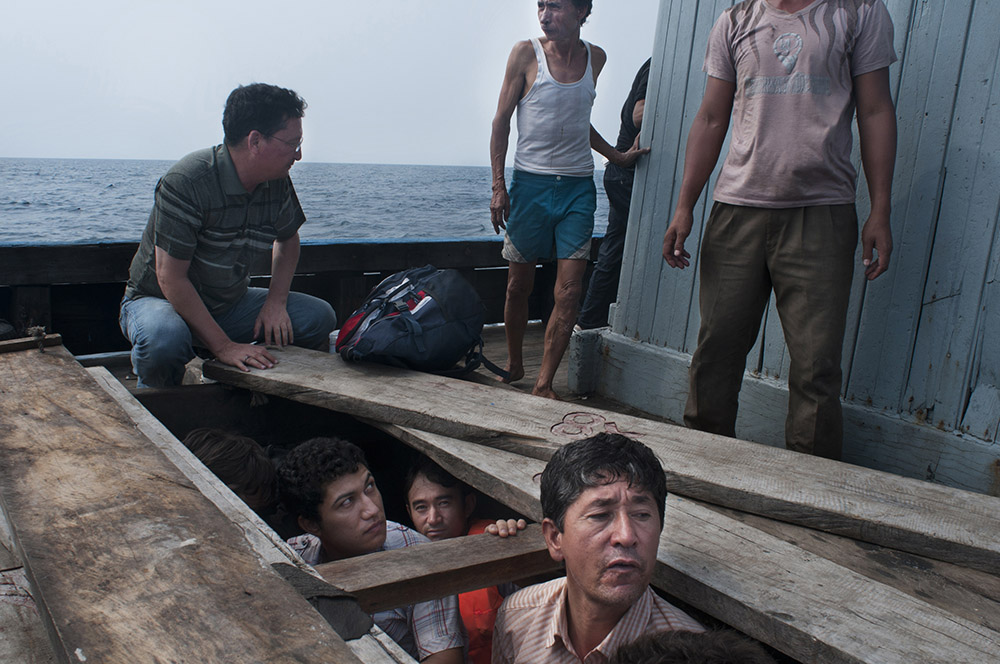
'First day at sea.' With 93 asylum seekers hidden below deck people take it in turns to sit near an open hatch to get fresh air. This photo was part of Ali Batoor’s winning submission in the 2013 Walkley Awards.
It was the beginning of a journey that would change Batoor’s life. “When I went to Afghanistan and saw the destruction and devastation, I wanted to do something. Then I saw the foreign photojournalists working and realised that if I could also become a photographer, I might be able to help the country. I used the money I made as an interpreter to buy my first camera.”
Batoor’s first camera was a Nikon FM10, a totally mechanical 35mm film camera. After getting a few basic lessons from a friend, Batoor began taking random shots in the streets of Quetta and soon afterwards he started to photograph weddings.
But having now experienced life in his ancestral homeland, Batoor decided in 2005 to return to Afghanistan. He moved to Bamyan, the town in central Afghanistan famous for its large sixth-century Buddha statues which were destroyed by the Taliban in 2001. There he got an administrative job with the International Organisation for Migration office, and in his spare time Batoor took photographs of the region and its people.

Bamyan, Afghanistan. 2006
Two years later, when his admin job came to an end, Batoor moved to Kabul and brought his mother and siblings across from Pakistan to join him. His father died in 2007 and Batoor became the family’s main provider. Soon after arriving in Kabul, Batoor organised his first exhibition, a collection of photographs documenting daily life in Bamyan. The work received strong reviews and Batoor was given encouragement to take up photography as a profession. He gave up working in offices and began making photography for humanitarian aid groups and other NGOs in the region.
Despite being at the centre of one of the world’s largest conflicts for the past decade, Batoor has maintained a preference for documentary rather than news photography. “I never wanted to do news photography. Since the beginning, I have always preferred documentary photography because you get to go to more to the core of the problems and explore the stories properly. News photography has a very short life, but documentary photography is there forever.”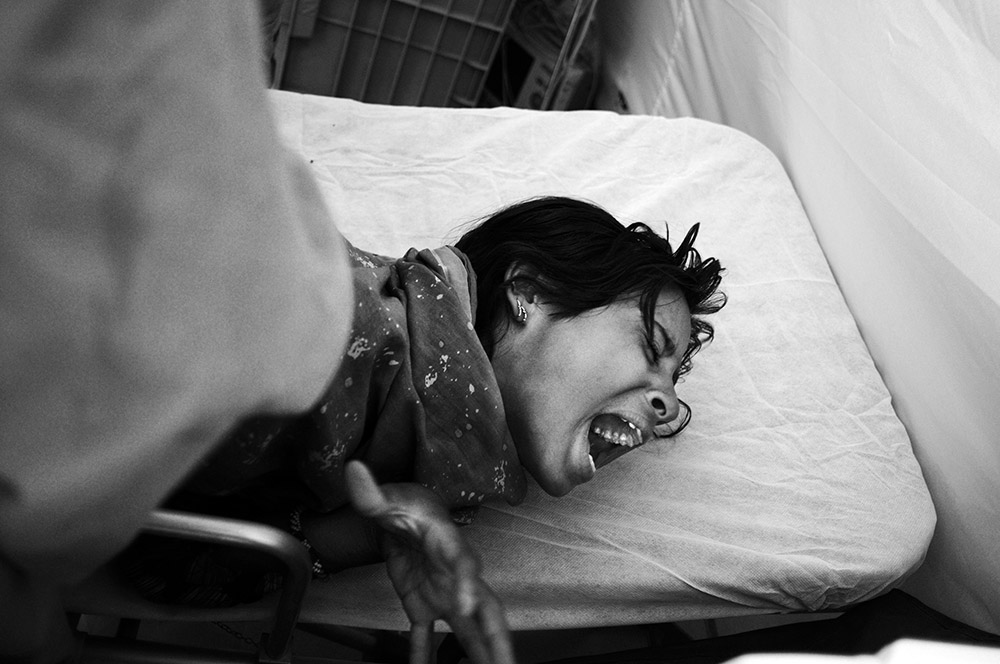
A young girl suffering from a skin infection cries out in pain while receiving treatment in a Turkish medical camp in Dera Murad Jamali, Pakistan.
Batoor also sees documentary photography as a tool for change. After the ‘Dancing Boys of Afghanistan’ story was published, the under secretary general of the United Nations and special representative for children in armed conflict, Radhika Coomaraswamy, met with Batoor and soon afterwards pressure was being put upon the Afghan government to try and stop the practice.
But the publication of the ‘Dancing Boys’ story also brought the death threats and in 2012 Batoor moved his family back to Quetta. The situation in Pakistan was not much better, though. Other ethnic groups were boycotting Hazaras; they were being denied access to education, work and even the ability to walk to the local bazaar (market). Batoor realised the only way he could support his mother, brothers and sisters was to find work in another country. He met with a people smuggler, paid his money and began a journey to Australia.
The first part of the journey was legal; the smuggler organised a visa and an international flight for Batoor to get from Pakistan to Thailand. Once there, Batoor travelled to the small town of Sungai Kolok on the Thailand-Malaysia border and met other asylum seekers, most of whom were Afghan Hazaras. In broad daylight, the group was transported by speedboat across the Golok River to the Malaysian side of the border. After a five-hour car journey to Kuala Lumpur, the group of 20 asylum seekers was locked in a house for three days before being transported by van to a beach on Malaysia’s west coast. There, another boat smuggled the group across the Malacca Strait to the Indonesian island of Sumatra.
The next part of the journey was a domestic flight across to Jakarta and then a drive to the nearby town of Bogor, where asylum seekers wait for people smugglers to organise their passage to Christmas Island. Several weeks later, Batoor and 90 other asylum seekers were on the south coast of Java for the final leg of their journey. Their boat left the Indonesian coast with 93 people hidden below deck in stifling conditions. People would take it in turns to sit near an open hatch to get fresh air.
The first night of the journey was calm, but by the second night the conditions began to deteriorate. Batoor recalls: “The water was very rough, and then the bilge pump stopped working. Those who were not seasick tried to remove the water in buckets, but more water was coming in than going out. Our boat was floating like a matchbox. There was screaming, shouting and crying. Everybody lost hope and we were thinking that this was the end and that everyone was dying.” 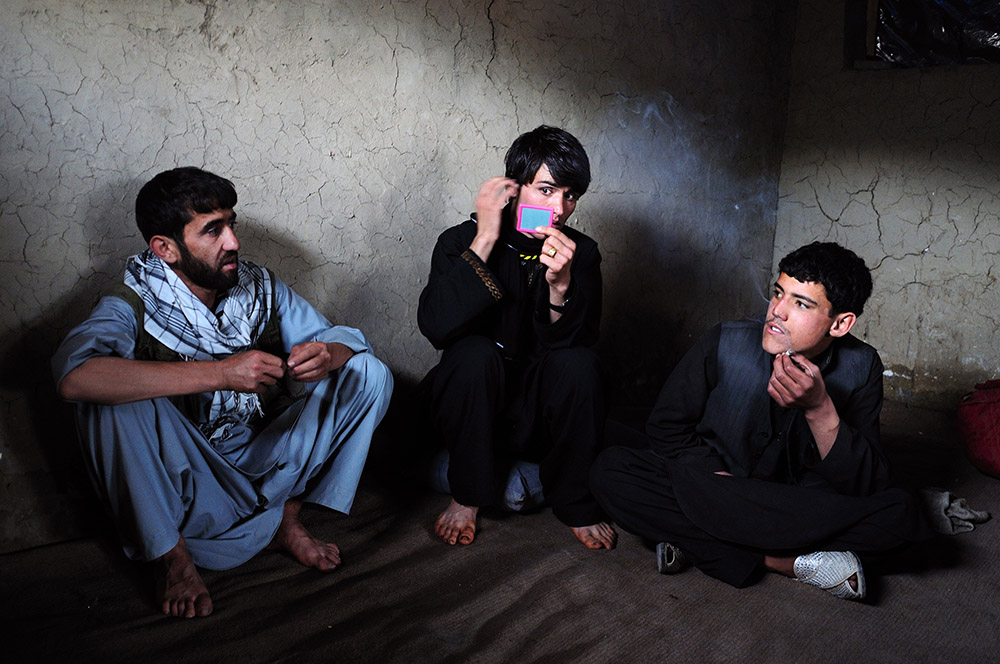
While sitting in a tea shop in Kabul, Shukur (centre) checks his face in a small mirror while his friends watch on.
The boat’s captain then made a decision which probably saved lives. Rather than continuing to Christmas Island, he decided to turn back to Indonesia. A few hours later the boat hit the rocky coastline of Java and as it began to sink people were forced into the water. Batoor, who had been taking photographs throughout his journey from Pakistan, captured photos of the asylum seekers struggling to shore. Nobody drowned, but Batoor’s Nikon D300 camera did not fare so well. Seawater ruined it, although the memory cards with Batoor’s photos of the journey survived.
After spending two nights on the rugged coastline, the group was found by Indonesian Water Police, arrested and taken to an immigration detention centre in Serang. But after just one day in the detention centre, Batoor and a friend began planning an escape. “I never wanted to spend my life in a detention centre because it was not the thing for me; I always wanted to be free. Early the next morning we escaped. In the detention centre they took all our money, shoes and mobile phones… everything and so we escaped by bare foot from there. The wall was very high and had sharp glass in it, and so we used pillows and bed sheets to protect our arms and feet. Once over the wall we caught a taxi back to Jakarta.”
Just weeks before getting on the boat to Christmas Island, Batoor had met with a Jakarta-based journalist from The Global Mail news website, Aubrey Belford, but the interview did not go well. A meeting with a people smuggler that same day was a distraction for Batoor, so Belford gave him his card and suggested he contact him another time.
Now, with no money or shoes, and a taxi driver to pay, Batoor decided it might be time to give Belford a call. The journalist met Batoor and his fellow escapee at dawn on a Jakarta roadside, and as Belford discussed their ordeal and learned of Batoor’s photos, he realised the potential of the story. Batoor’s photos of his journey were published that week in The Global Mail and soon afterwards Australian journalist Mark Davis compiled a half-hour documentary on Batoor and other Hazara asylum seekers for the SBS Dateline program. After years of seeing these boats from a distance, the Australian public finally had an opportunity to engage personally with this story. Batoor’s photos captured in clear detail the faces of the asylum seekers, along with the fear and anxiety they were experiencing.
While some of the survivors from Batoor’s boat trip went back to Bogor to attempt another sea journey, Batoor decided not to risk his life again and instead made a formal application to the United Nations High Commissioner for Refugees (UNHCR). This process of waiting to be certified as a refugee can often take years, but Batoor’s case was expedited by the media coverage. He was certified in just under a year and offered resettlement in Australia. After being flown to Darwin he travelled to Sydney and he has since settled in Melbourne.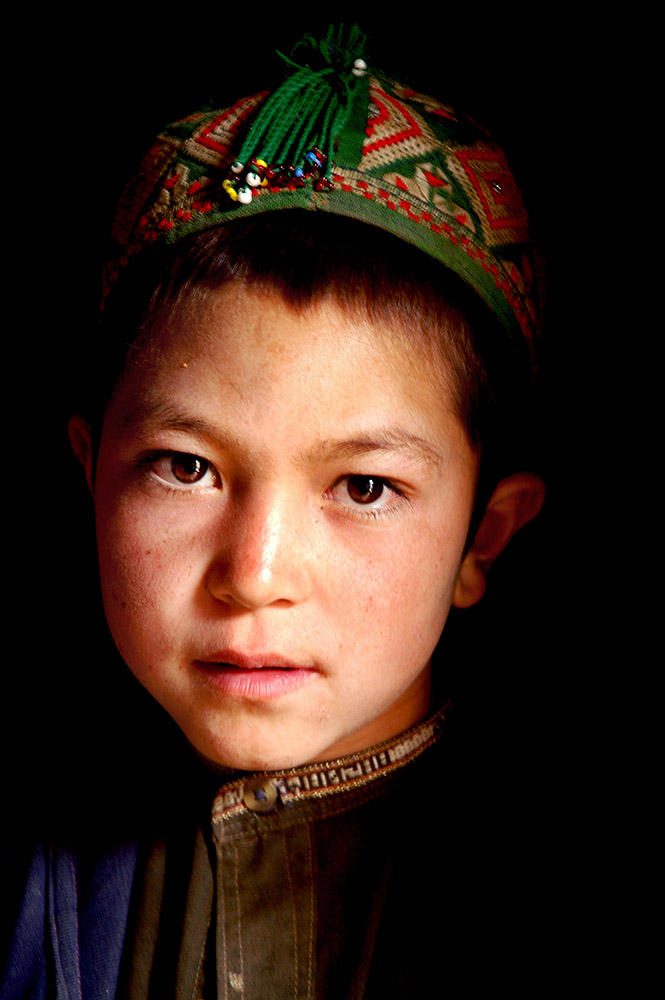
Portrait of a young boy in Behsud, Afghanistan, 2006.
Like the thousands who make the move to Australia every year, Batoor would probably have been lost in the crowd until a photographer friend suggested he should enter his photographs in the Walkley Awards (a prestigious media award system set up in 1956 for journalists). Last November at the Walkley Awards gala dinner in Brisbane, Batoor was called to the stage twice; first to receive the Nikon-Walkley award for Best Feature/Photographic Essay and then later to receive the top photographic honour, the Nikon-Walkley Photo of the Year award.
Batoor says he was surprised to win, but was also very pleased. And while the feat has not had much effect on his Australian photographic career yet, he feels it has helped raise awareness for the plight of the Hazara people.
Currently Batoor is working for the Adult Migrant English Service as a community guide, but he’s still working in his spare time as a documentary photographer. That includes looking at how the Hazara people integrate into Australian society.
He is hoping these images will become part of a book and also a film that document the journey of Hazara asylum seekers from Afghanistan to Australia. He says, “If I can make a difference, I will be happy to do what I can.” ❂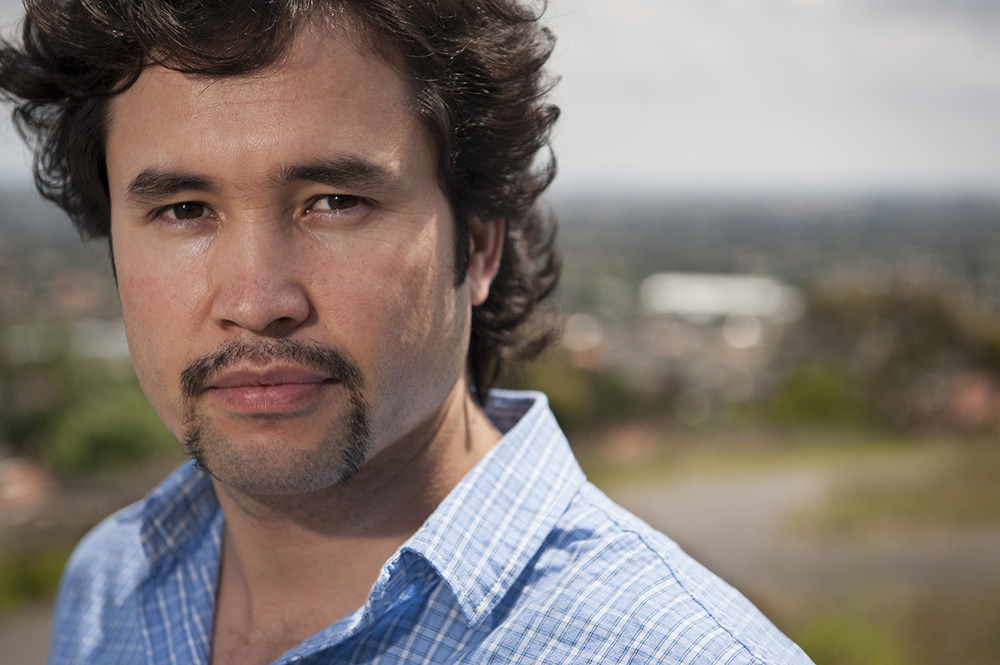
Barat Ali Batoor now lives in Melbourne.









